
#1: Red and Green Hot Chili Peppers
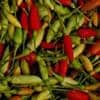
An excellent way to spice up soups, curries, and sauces, green chillies provide the most vitamin C than any other food with 242.5mg (404% RDA) per 100 gram serving, 181.88mg (303% RDA) in a half cup chopped, and 109.13mg (182% RDA) in a single green chili pepper. Red chillies provide 144mg (240% RDA) of vitamin C per 100g serving, 108mg (180% RDA) per half cup chopped, and 65mg (108% RDA) per pepper. Click to see complete nutrition facts.
#2: Guavas
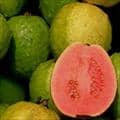
Depending on variety, guavas can provide as much as 228mg (381% RDA) of vitamin C per 100g serving, 377mg (628% RDA) per cup, and 126mg (209% RDA) per fruit.
#3: Bell Peppers
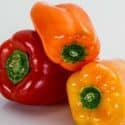
A staple of pasta sauce and pizza the sweet bell pepper packs a high vitamin C punch. The amount of vitamin C depends on color. Yellow peppers provide the most vitamin C with 184mg (206% RDA) per 100 gram serving, 341mg (569% RDA) per pepper, and 95mg (159% RDA) in 10 sliced strips. Green peppers provide the least vitamin C with 132mg (220% RDA) per pepper. Click to see complete nutrition facts.
#4: Fresh Herbs (Thyme and Parsley)

Fresh and dried herbs are packed with vitamins and health benefits, they can be used in almost any soup, stew, or as the main ingredient to a salad like tabouleh. Thyme provides the most vitamin C of any herb with 160mg (267% RDA) per 100 gram serving, 1.6mg (3% RDA) in a single teaspoon. Parsley provides 133mg (222% RDA) per 100 gram serving, 79mg (133% RDA) per cup, 5mg (9% RDA) per tablespoon, 13.3mg (22% RDA) in 10 sprigs. Click to see complete nutrition facts.
#5: Dark Leafy Greens (Kale, Mustard Greens, Garden Cress)
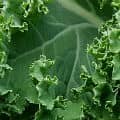
Dark leafy greens are more than just a source of calcium, and are packed with other vitamins including vitamin C. Raw kale provides the most vitamin C with 120mg (200% RDA) per 100 gram serving, 80mg (134% RDA) per cup chopped. It is followed by mustard greens which provide 70mg (117% RDA) per 100 gram serving, and 29mg (65% RDA) per cup chopped. Garden cress provides 69mg (115% RDA) per 100 gram serving, or 35mg (58% RDA) per cup. Click to see complete nutrition facts.
#6: Broccoli, Cauliflower, Brussels Sprouts

Broccoli provides 89mg (149% RDA) of vitamin C in a 100g serving, 81mg (135% RDA) per cup chopped, 28mg (46% RDA) per piece. Raw cauliflower provides much less with 46mg (77% RDA) per cup, raw brussles sprouts provide 75mg (125% RDA) per cup, 16mg (27% RDA) per sprout. Click to see complete nutrition facts.
#7: Kiwi Fruits (Chinese Gooseberries)

Kiwi fruits are tart as well as decorative, they make a great addition to any fruit salad or dessert. A 100g serving will provide 93mg (155% RDA) of vitamin C, that is 164 mg (273% RDA) per cup, 84mg (141% RDA) per fruit.
#8: Papayas (aka: Lechoza, Mamão, Pawpaw)
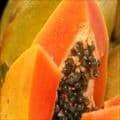
In addition to vitamin C, papaya is also a great source of vitamin A and folate (vitamin B9). Papaya provides 62mg (103% RDA) per 100 gram serving, that is 87mg (144% RDA) per cup cubed, and 188mg (313% RDA) in a medium sized papaya.
#9: Oranges and Clementines (Tangerines)
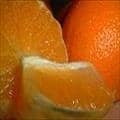
Oranges, citrus fruits, and their zest (the shavings of their peel) are all high in vitamin C. Oranges provide 59mg (99% RDA) per 100 gram serving, 98mg (163% RDA) per cup, and 83mg (138% RDA) per orange. Clementines, or tangerines, provide 49mg (81% RDA) per 100 gram serving, or 36mg (60% RDA) per fruit.
#10: Strawberries

Strawberries are delicious and make a great addition to desserts or drinks. Strawberries provide 59mg (98% RDA) per 100 gram serving, 98mg (163 % RDA) per cup slices, and 11mg (18% RDA) in a single large strawberry.
Other Vitamin C Rich Foods
| Acerola (West Indian Cherry) | 1678mg (2796% RDA) per 100 gram serving | 1644mg (2740% RDA) per cup (98 grams) | 84mg (140% RDA) per cherry (5 grams) | Click to see complete nutrition facts for Acerola (West Indian Cherry) |
| Black Currants | 181mg (302% RDA) per 100 gram serving | 203mg (338% RDA) per cup (112 grams) | 13mg (21% RDA) per tablespoon (7 grams) | Click to see complete nutrition facts for Black Currants |
| Pummelos | 61mg (102% RDA) per 100 gram serving | 116mg (193% RDA) per cup (190 grams) | 371mg (619% RDA) per fruit (609 grams) | Click to see complete nutrition facts for Fresh Pummelos |
| Sun-Dried Tomatoes | 102mg (170% RDA) per 100 gram serving | 112mg (187% RDA) per cup (110 grams) | 3mg (5% RDA) per piece (3 grams) | Click to see complete nutrition facts for Oil Packed Sun-Dried Tomatoes |
| Banana Peppers | 83mg (138% RDA) per 100 gram serving | 103mg (171% RDA) per cup (124 grams) | 38mg (63% RDA) per pepper (46 grams) | Click to see complete nutrition facts for Raw Banana Peppers |
| Turnip Greens | 60mg (100% RDA) per 100 gram serving | 33mg (55% RDA) per cup (55 grams) | 2mg (3% RDA) per tablespoon (3 grams) | Click to see complete nutrition facts for Raw Turnip Greens |
| Chives | 58mg (97% RDA) per 100 gram serving | 2mg (3% RDA) per tablespoon (3 grams) | 0.5mg (1% RDA) per teaspoon (1 gram) | Click to see complete nutrition facts for Fresh Chives |
| Red Cabbage | 57mg (95% RDA) per 100 gram serving | 51mg (85% RDA) per cup (89 grams) | 13mg (22% RDA) per leaf (23 grams) | Click to see complete nutrition facts for Fresh Red Cabbage |
| Cantaloupe | 37mg (61% RDA) per 100 gram serving | 57mg (95% RDA) per cup diced (156 grams) | 20mg (34% RDA) per wedge (55 grams) | Click to see complete nutrition facts for Raw Cantaloupe |
| Tomatoes | 23mg (39% RDA) per 100 gram serving | 42mg (70% RDA) per cup (180 grams) | 29mg (48% RDA) in a medium tomato (123 grams) | Click to see complete nutrition facts for Raw Tomatoes |
| Fortified Cereals* | 210mg (350% RDA) per 100 gram serving | 168mg (280% RDA) in an average bowl (2 cups) (80 grams) | 84mg (140% RDA) per cup (40 grams) | Click to see complete nutrition facts for Fortified Cereals |
| Coriander (Dry) | 567mg (945% RDA) per 100 gram serving | 11mg (19% RDA) per tablespoon (2 grams) | 6mg (9% RDA) per teaspoon (1 gram) | Click to see complete nutrition facts for Dried Coriander |
| Cloves (Ground) | 81mg (135% RDA) per 100 gram serving | 6mg (9% RDA) per tablespoon (7 grams) | 2mg (3% RDA) per teaspoon (2 grams) | Click to see complete nutrition facts for Ground Cloves |
| Saffron | 81mg (135% RDA) per 100 gram serving | 2mg (3% RDA) per tablespoon (2 grams) | 1mg (1% RDA) per teaspoon (1 gram) | Click to see complete nutrition facts for Saffron |
| Red Pepper (Cayenne) | 76mg (127% RDA) per 100 gram serving | 4mg (6% RDA) per tablespoon (5 grams) | 2mg (3% RDA) per teaspoon (2 grams) | Click to see complete nutrition facts for Red Pepper (Cayenne) |
| Chili Powder | 64mg (107% RDA) per 100 gram serving | 5mg (9% RDA) per tablespoon (8 grams) | 2mg (3% RDA) per teaspoon (3 grams) | Click to see complete nutrition facts for Chili Powder |
| Basil (Dried) | 61mg (102% RDA) per 100 gram serving | 1.2mg (2% RDA) per tablespoon (2 grams) | 0.6mg (1% RDA) per teaspoon (1 gram) | Click to see complete nutrition facts for Dried Basil |
| Rosemary(Dried) | 61mg (102% RDA) per 100 gram serving | 2mg (3% RDA) per tablespoon (3 grams) | 0.6mg (1% RDA) per teaspoon (1 gram) | Click to see complete nutrition facts for Dried Rosemary |
Health Benefits of Vitamin C
- Alleviation of Cardiovascular Disease and High Blood Pressure - Several studies support that consuming at least 500mg a day of vitamin C can increase the amount blood vessels relax, or dilate, in a process known as vasodilation. This process is thought to help lower blood pressure, reducing risk of heart attack and other cardiovascular diseases.3
- Increased Immune Function (*Controversial) - Vitamin C has a reputation for boosting immune function and possibly preventing incidence of the common cold. Repeated studies have show this is not true for the general population,4,5and the effect of vitamin C reducing the incidence of cold is mostly seen in those with a vitamin C deficiency, and in athletes under intense physical strain.4
- Increased Iron Absorption - Vitamin C increases iron absorption, however, this should be noted with care, as too much vitamin C can lead to iron toxicity in certain individuals.6
People at Risk of a Vitamin C Deficiency
- Smokers and Passive Smokers - Studies show that smokers have lower levels of vitamin C in their blood than non-smokers, and this is thought to be due to increased oxidative stress. Similarly, those regularly exposed to passive smoke have lower levels of vitamin C in their blood. People in these groups are advised to consume more vitamin C, up to 35mg (50%) more than non-smokers.7
- Infants given boiled or evaporated milk - Boiling or evaporating milk destroys any vitamin C it provides leaving infants deficient.8 However, most infant formulas come already fortified with vitamin C, check nutrition facts of a specific product to be sure.
- People without varied diets - Vitamin C is found mainly in fresh fruits and vegetables. People who do not eat these foods or who do not vary their diet greatly are at risk of vitamin C deficiency.
- People with malabsorption or chronic diseases - People with malabsorption diseases, like cachexia, are at increased risk of vitamin C deficiency. Other high risk groups include those with cancer, end-stage renal disease (kidney failure), or chronic hemodialysis.9,10

0 comments:
Post a Comment